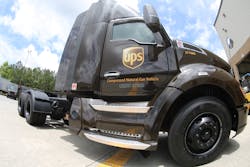Case Study: UPS makes facility modifications to service natural gas vehicles
UPS first added compressed natural gas (CNG) to its fleet in 1989, later delving into liquid natural gas (LNG) in 2002. The company has made significant investments in this alternative fuel over the past few years, most recently adding more than 700 CNG vehicles in June. The UPS fleet now operates well over 5,000 CNG and LNG vehicles including semi-tractors, terminal trucks and delivery vehicles. UPS also operates more than 50 natural gas fueling stations.
Rick Jordan, automotive senior director of maintenance and engineering for the UPS delivery fleet, says the company’s maintenance facilities have had to undergo some modifications. The primary monetary investment has come by way of additional exhaust fans in many of the facilities. Additionally, the company decided to install methane detection systems in all facilities – even though detection systems are considered optional for facilities servicing just CNG.
“When you have a coast-to-coast operation like UPS, it’s important to think about all of the different codes and requirements that are out there,” Jordan says. “We developed a natural gas program that encompasses all of the different codes we encounter because we like to standardize facilities and training as much as possible. Some jurisdictions require methane detection, and that has meant installing methane detection systems in all facilities.”
As Jordan points out, no two facilities are the same. Standardization is great, at least to the degree to which a fleet can achieve it. In some instances, UPS established stand-alone natural gas facilities. In other instances, only part of an existing facility was modified to work on natural gas.
“Depending on local codes, we typically had to build some additional walls to contain the natural gas shop area from the rest of the operation,” Jordan says.
Once the modifications happen and the infrastructure is in place, Jordan says a fleet is ready to begin reaping the benefits of natural gas. Standard operating procedures, PPE and training cannot be neglected, though – especially in those instances where only a portion of an existing facility has been modified. When fleets provide evacuation training for a stand-alone facility, only the people working in that facility need the training. But when fleets have a split facility, it’s important that everyone understands what is going on and receives the training.
About the Author

Gregg Wartgow
Gregg Wartgow is a freelancer who Fleet Maintenance has relied upon for many years, writing about virtually any trucking topic. He lives in Brodhead, Wisconsin.
